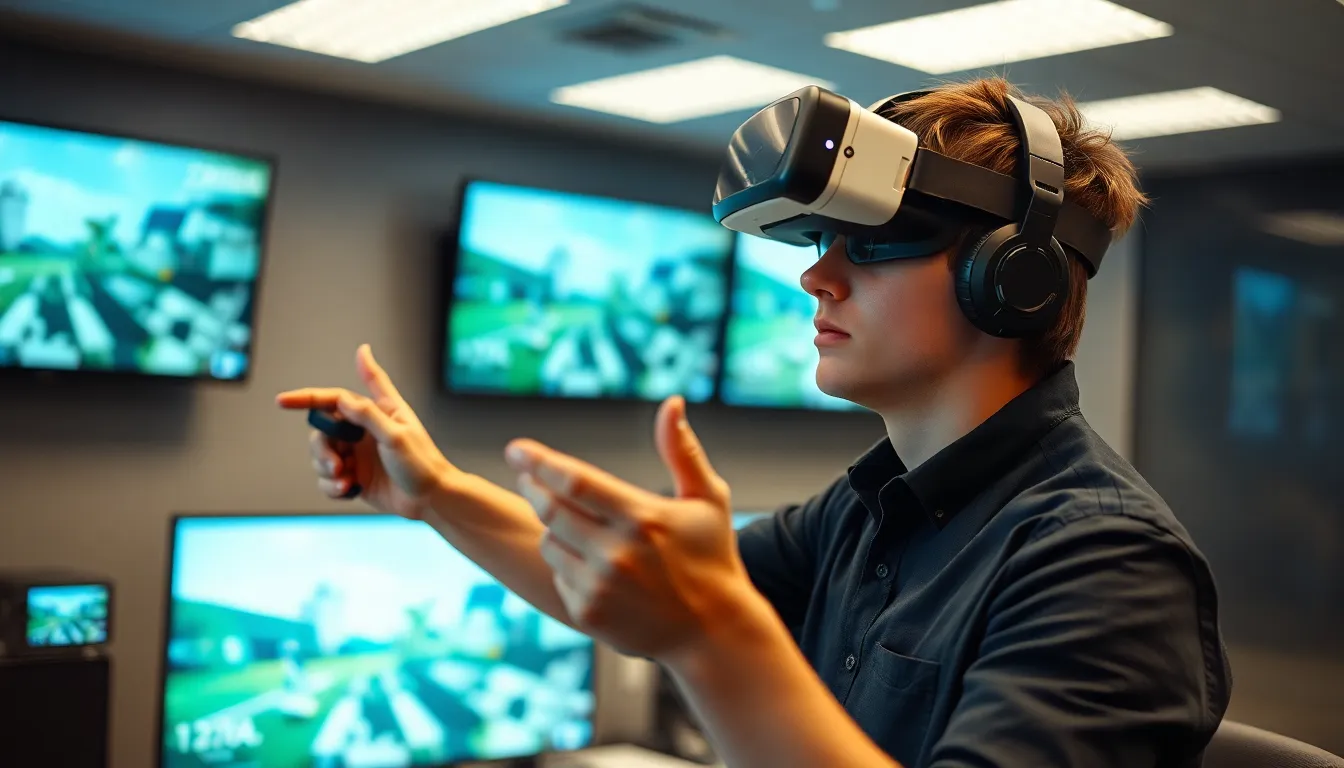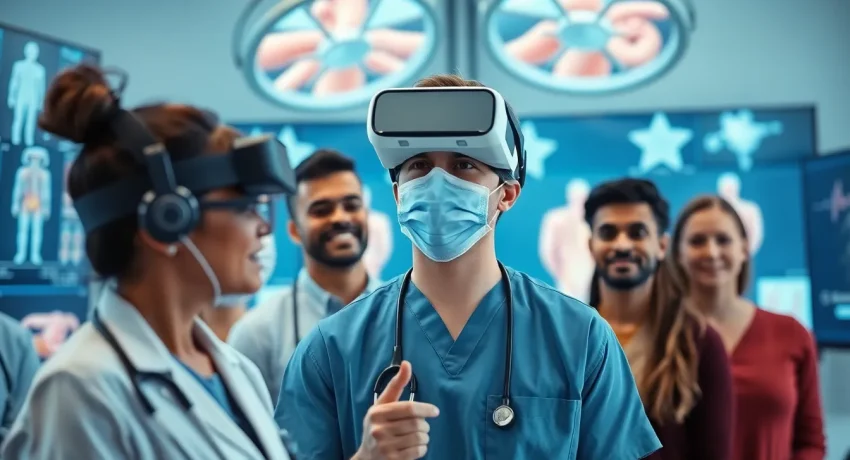Imagine stepping into a world where gravity’s just a suggestion and the laws of physics take a coffee break. Welcome to the realm of simulated environments, where reality meets creativity in a captivating dance. These virtual playgrounds aren’t just for gamers; they’re revolutionizing industries from education to healthcare, offering a safe space to learn, experiment, and even fail without the messy consequences.
As technology advances, so does the potential of these digital landscapes. Whether it’s training astronauts for a space mission or helping surgeons perfect their skills, simulated environments are the unsung heroes of modern innovation. So buckle up and get ready to explore how these fantastical realms are shaping our future—because who wouldn’t want to practice brain surgery in a virtual hospital before hitting the real deal?
Table of Contents
ToggleOverview of Simulated Environments
Simulated environments serve as virtual replicas of real-world settings, enabling users to engage with complex scenarios safely. They empower industries to create realistic experiences that facilitate training and skill development without real-world risks.
In education, these environments enhance learning by providing interactive platforms. Students and instructors access personalized simulations that encourage active participation and problem-solving. For example, medical students practice surgeries in virtual operating rooms, honing skills before touching real patients.
Healthcare also benefits significantly from these technologies. Surgeons use simulation to refine techniques and learn new procedures, which results in improved patient safety outcomes. Furthermore, emergency responders train in simulated disaster scenarios, preparing for high-stress situations effectively.
Military training extensively relies on simulated environments. Soldiers experience combat scenarios that replicate battlefield conditions, enabling them to develop tactical skills in a controlled space. This method reduces training costs and enhances preparedness.
Business sectors leverage these environments for product design and marketing. Companies utilize simulations to visualize products and analyze consumer behavior, leading to data-driven decisions.
Overall, simulated environments provide invaluable tools across various disciplines. They encourage innovation through risk-free experimentation, facilitating skill enhancement that translates to the real world.
Types of Simulated Environments

Simulated environments come in various forms, each serving unique purposes across industries. Understanding the types ensures effective application in different contexts.
Virtual Reality
Virtual reality immerses users in a digital landscape, separating them from the physical world. This environment provides a fully interactive experience, often using headsets. Users explore scenarios, such as battlefield simulations or complex medical procedures. Healthcare professionals improve their skills by practicing surgeries in this safe space. Industries utilize virtual reality for employee training, allowing for realistic role-play situations. The technology demonstrates versatility, making it applicable in education as well. Students learn through engaging simulations that replicate real-life challenges.
Augmented Reality
Augmented reality overlays digital elements onto the real world, enhancing user interaction with their surroundings. This technology uses devices such as smartphones or smart glasses. Users see information pop up on their screens, blending the virtual with the tangible. In retail, customers try on clothes virtually before purchasing. Industries leverage augmented reality for training, adding layers of information that guide learners. Engineers utilize this technology for maintenance tasks, accessing instructions while working on equipment. It transforms how individuals visualize and interact with their environment.
Applications of Simulated Environments
Simulated environments offer diverse applications across multiple fields. They enhance learning, facilitate entertainment, and drive innovation.
Education and Training
In education and training, simulated environments improve skill acquisition. Students practice procedures such as surgery or aviation in virtual settings. This immersive approach allows learners to experience realistic scenarios without any risks. Engaging with complex subjects becomes easier through interactive simulations. Teachers can track progress and provide instant feedback. Programs like flight simulators and virtual labs exemplify these applications, making learning effective and safe.
Entertainment and Gaming
Entertainment and gaming benefit from the vibrant experiences provided by simulated environments. Gamers immerse themselves in lifelike digital worlds, fostering engagement and excitement. Role-playing games and adventure simulations create narratives that captivate vast audiences. Virtual reality experiences, such as immersive theme park attractions, enhance the enjoyment factor. Enhanced graphics and interactive elements elevate player involvement, pushing boundaries in gameplay dynamics.
Research and Development
Research and development leverage simulated environments to test theories and prototypes. Scientists model phenomena to observe outcomes without practical experimentation. This approach accelerates the pace of innovation by identifying potential challenges early on. Industries, such as automotive or aerospace, rely heavily on simulations to evaluate designs. Researchers can make adjustments based on data collected, streamlining the development process.
Benefits of Simulated Environments
Simulated environments offer numerous advantages across various sectors, enhancing learning and operational effectiveness. They create a safe space for individuals to practice and hone skills without the risk of real-world consequences. In education, these platforms enable students to engage in practical exercises that solidify theoretical knowledge.
Healthcare professionals gain significant benefits from simulations, as they can practice surgical techniques or emergency response scenarios repeatedly. This iteration fosters confidence and improves decision-making under pressure. Additionally, medical training environments can mirror real-life patient interactions, allowing for a more comprehensive learning experience.
The military utilizes simulated environments to conduct tactical training, replicating various combat situations. Such training improves coordination and strategic planning, enhancing overall readiness. Soldiers can familiarize themselves with equipment and procedures in lifelike settings, increasing efficiency when it matters most.
Businesses leverage simulations to prototype products and analyze consumer behavior. By modeling various scenarios, companies can identify potential risks and optimize design processes before final implementation. This capability significantly shortens development cycles and reduces costs associated with physical testing.
In research, simulated environments allow for experimentation in controlled settings. Scientists can manipulate variables and observe outcomes without ethical dilemmas or real-world implications. This method accelerates the discovery process, providing insights that might remain hidden in traditional settings.
Overall, simulated environments enhance learning, improve safety, and foster innovation across multiple fields. Their effectiveness in providing hands-on experience while mitigating risk positions them as essential tools for training and development.
Challenges and Limitations
Simulated environments face several challenges that can impact their effectiveness. High development costs often hinder widespread adoption. Creating realistic simulations requires significant financial investment in technology and expertise. Furthermore, ongoing maintenance and updates add to the overall expense.
User adaptability presents another challenge. Individuals unfamiliar with virtual reality or augmented reality might struggle to engage with these technologies. Training users to navigate these environments takes time and resources, potentially delaying implementation in various fields.
Technical limitations can also restrict the experiences offered within simulated environments. Hardware constraints, such as processing power and graphics capabilities, impact realism. Inadequate technology can lead to a diminished user experience, affecting the overall effectiveness of training.
Data privacy remains a significant concern. Collecting sensitive information during training or experimentation raises ethical questions. Organizations must ensure proper data protection measures are in place to prevent unauthorized access.
Another limitation involves the risk of desensitization. Repeated exposure to simulated scenarios may lead to emotional detachment. Users could become less responsive during real-life situations due to over-familiarity with virtual experiences.
Finally, the effectiveness of simulations often relies on a well-designed framework. Poorly developed scenarios can result in misaligned training outcomes and ineffective learning. Continuous evaluation and refinement are essential to maintain relevance and ensure the desired impact.
Simulated environments are revolutionizing how industries approach training and development. By providing safe and controlled settings for practice, they enhance learning outcomes and operational efficiency. The ability to engage in realistic scenarios without real-world risks is invaluable, especially in fields like healthcare and military training.
Despite the challenges in implementation, the benefits of these virtual spaces are undeniable. As technology continues to evolve, the potential for simulated environments to foster innovation and improve skill acquisition will only grow. Embracing these tools will be crucial for professionals seeking to stay ahead in their respective fields.




